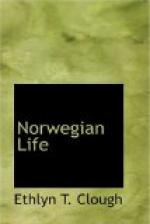In 1876, Alfred Nobel had perfected his invention of dynamite gum. He went to Paris with his patented invention, and there formed a company with a capital of ten million francs for the manufacture of dynamite. It proved to be an article of the greatest industrial importance, and one destined to revolutionize mining and engineering. Erelong he had established extensive works in France, Scotland, Germany, Belgium, Austria, and the United States. He produced over $25,000,000 worth a year. He became, in fact, the world’s purveyor of an article which was now exclusively used in mining and engineering works. Thanks to it, engineers were able to pierce tunnels through the Alps, miners to sink their shafts into the bowels of the earth, and harbor constructors to remove sunken rocks out of the way of shipping. But thanks to it, too, the Communards were enabled to blow up the finest monuments of Paris in a few hours. It was at once a powerful instrument of industrial development, and of progress in the conquest of man over inert matter, and a terrible engine of devastation in warfare, and of massacre and vandalism where homicidal and destructive passions were aroused in mankind.
It was perhaps this thought, that in benefiting industry he had also made war more destructive, which led Alfred Nobel, who was a most pacific and humane man, endowed with the kindliness and sympathy of a great mind, to make the provisions he did in his will. He devoted all his fortune to the encouragement of scientific discovery and the reward of endeavors to diminish standing armies and the chances of war, to promote fraternity among nations, and the settlement of international disputes by peace congresses. His will, in its very conciseness and unsophisticated simplicity, is characteristic of the man. It is dated Nov. 27, 1895, and he died a year afterwards, on Dec. 10, 1896, leaving a fortune of $10,000,000. After instituting several small legacies, the will proceeds:
“With the residue of my convertible estate I hereby direct my executors to proceed as follows: They shall convert my said residue of property into money, which they shall then invest in safe securities; the capital thus secured shall constitute a fund, the interest accruing from which shall be annually awarded in prizes to those persons who shall have contributed most materially to benefit mankind during the year immediately preceding. The said interest shall be divided into five equal amounts, to be apportioned as follows: one share to the person who shall have made the most important discovery or invention in the domain of physics; one share to the person who shall have made the most important chemical discovery or improvement; one share to the person who shall have made the most important discovery in the domain of physiology or medicine; one share to the person who shall have produced in the field of literature the most distinguished work of an idealistic tendency; and, finally, one share to the person who shall have




